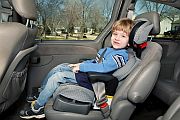- Navigating Your Midlife Crisis: Embracing New Possibilities
- City Raccoons Showing Signs of Domestication
- Mapping the Exposome: Science Broadens Focus to Environmental Disease Triggers
- One Week Less on Social Media Linked to Better Mental Health
- Your Brain Changes in Stages as You Age, Study Finds
- Some Suicide Victims Show No Typical Warning Signs, Study Finds
- ByHeart Formula Faces Lawsuits After Babies Sickened With Botulism
- Switch to Vegan Diet Could Cut Your Greenhouse Gas Emissions in Half
- Regular Bedtime Does Wonders for Blood Pressure
- Dining Alone Could Mean Worse Nutrition for Seniors
Many Parents Overlook Booster Seat Safety


Kids old enough to use booster seats are twice as likely to be seriously injured or killed in car accidents as babies are. But, these bigger car seats are often overlooked during safety inspections, a new study finds.
Used correctly, booster seats can reduce the risk of injuries among kids between the ages of 4 and 8 by 45 percent, the researchers said.
“Booster seats seem less technical and complicated than installing an infant seat, which may lead parents and families to worry less about using them incorrectly,” said study senior author Dr. Michelle Macy, of the University of Michigan’s C.S. Mott Children’s Hospital and the hospital’s Child Health Evaluation and Research Unit.
“We know that older kids are at particular risk of injury from a car crash. Our study suggests it may be beneficial for certified child passenger safety technicians to focus more on providing education and guidance on prolonged use of booster seats,” she said in a hospital news release.
Researchers analyzed data from more than 4,500 car seat inspections in Michigan. They found just 11 percent of these safety checks involved booster seats for kids between the ages of 4 and 7, while about half of these inspections were for rear-facing infant car seats. Meanwhile, about one-third of the booster seats examined needed an adjustment that made them safer.
The findings were published recently in the Journal of Trauma.
Oftentimes, children aged 4 and older at these inspections were there because of a car seat check for a younger sibling — not to have their own seat checked.
The researchers pointed out many safety initiatives focus on car seat inspections for infants and toddlers, while few address safety issues associated with older kids’ booster seats.
Lead author Amber Kroeker, who conducted the study while a researcher at the University of Michigan, said, “Study after study shows that caregivers often need support and direction when choosing and installing child restraints and that they are often using them incorrectly, which puts child passengers at unnecessary risk of harm.”
“This gap can be addressed in car seat inspections, which are free and offered in most communities, but our findings indicate low use of this service by parents of older children,” she said in the news release.
Also, children between the ages of 4 and 12 who switch from booster seats to seat belts before they should are at risk for serious injuries to their abdomen, the researchers said. These injuries, known as “seat belt syndrome,” include internal injuries in the belly and spinal cord, as well as facial injuries.
A survey of 1,000 parents revealed that seven out of 10 parents are not aware that kids must be 57 inches tall before they meet the ideal fit requirements for a seat belt, the researchers pointed out. Nine out of 10 parents switched their kids from a booster seat to a seat belt too soon.
“Injury risk in motor vehicle accidents has been dramatically reduced for infants and toddlers because of an increased focus on proper restraints,” Kroeker said. “We want to see the same outcomes for older children.”
More information
The American Academy of Pediatrics provides more information on car seat safety.
Source: HealthDay
Copyright © 2025 HealthDay. All rights reserved.










